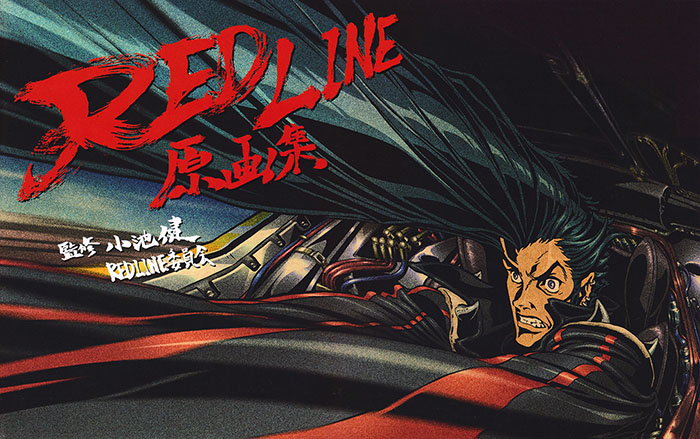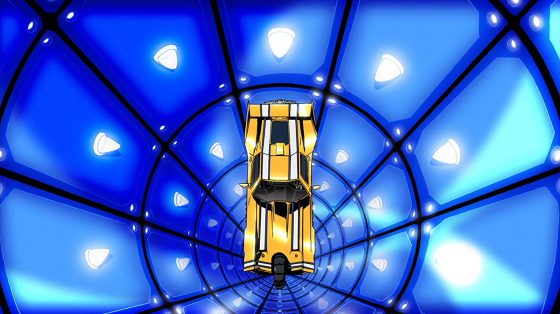
Redline is science fiction film about racing, famous for its spectacular animation and unique art style. Sporting a budget of 3 billion yen, studio Madhouse spent 7 years creating the film, resulting in one of the best visual splendors anime has to offer.
Redline is Takeshi Koike’s debut as a film director. Taking the reins, Koike directs a fast-paced, adrenaline-filled rush, a style that permeates into both its story, shots, and editing.
For this article, I will go into detail about how Redline is more than just a racing film. By showing how character designs unveil personality, how exposition is conveyed, and how multiple storylines are edited cohesively, I hope to show how the spirit of racing is captured in the world of Redline.
Reflections of Character: the Vehicle of Identity
It is not uncommon to view cars as extensions of the driver. Car promotional material and marketing sell them not just as a vehicle but as a catalyst for the spirit of adventure—freedom unrestrained.
Customizing your car can be seen as a way to display your personality. From external modifications like color to internal changes like hydraulic lifts to raise or lower your car, there is an entire culture behind personalizing your vehicle. You can learn just as much about a person from their car as you can from how they speak.
Redline is fully aware of this idea, evident through its character and car designs. Cars like the Machinehead Tetsujin are literal extensions of the body, his car exterior changing to fit his muscular frame. When he injects nitro, a booster that allows cars to run faster, his muscle burst like he used steroids.
The magical girl duo, or the “cosplaying rejects from a porno,” as the Robo World residents call them, are especially flamboyant. Their “magical transformation” turns their vehicle from machine to an over-the-top performance and visual “sensation.”
Part of the charm is how character designs communicate character. Not only do they wear their hearts on their sleeves, but each character races whole-heartedly for the finish line. That earnestness supplements an already adrenaline-filled movie.
Exposition: How Redline’s Gets Conveyed
Redline is a film where its pacing moves as quickly as its races. To convey its story, the film borrows its approach to its characters. Since character designs transfer to their vehicle designs and dialogue, viewers can make logical deductions on how a character will act.
This is the same with Redline’s story. Certain things can be logically deduced. For example, the first race is a qualifying race. If a driver manages to get past the yellow line first, then they win. Thus when that race is called the Yellowline, it’s literal.
The Redline, by inference, is a race with bigger bets at stake. If people must qualify, then this race is the best of the best. These logical deductions are also spelled out in the script.
The race of aliens on Robo World are the obstacles and antagonists on the film. The location of the Redline is on a demilitarized planet that they promised to leave for refugees. However, they break their promise and try to kill the racers, turning the Redline race into an obstacle course with bullets.
The Robo World characters, while not actual robots, are clearly depicted as the villains. Borrowing some conventions, they have a chessboard mapping their targets, a furless cat they pet, and a hyper disintegrator-cannon which they quite proudly named Literally.
Given their on-the-nose depictions, it’s fitting they also do the same in the story. When workers rebel against their Robo World overlords, the Robo villains state exactly that. When the Redline takes place close to home, they also state their disdain and concerns over hiding their military secrets. This kind of exposition is in-character, allowing readers to be aware without seeming tedious.
More than a Race: How Editing and Multiple Stories Converge
Woven into the film are storylines that converge on the Redline. To promote the race, the background stories for each racer is given a promotional video. Thus, each character is given time to market themselves.
To do this without seeming jarring, the film’s editing, specifically the transitions, must be creative, providing logic to the chaos. The promotional videos are peppered throughout the film, creating a pace akin to a race.
For example, after JP crashes by a “fluke,” the viewer is aware that what happened once could happen again. Once he’s voted into the Redline by fans—the fact that is only possible because two racers drop out due to the dangers of Robo World—JP goes to his trusted mechanic and asks for another car to win the Redline.
He eventually gets a test version of said car, only to crash it after. To transition properly, there is a news report of his crash, which then transitions back to the Redline Racer promo videos.
From there, two promo videos introduce characters: a Dirty Cop racer (Gori-Rider) and Miki and Todoruki, Japanese riders presumably from Earth. After seeing how Gori-Rider handles his “criminals,” we’re given a brief understanding of Miki and Todoruki. The video cuts short because they call Gori-Rider an expletive (on live television)—forcing the viewers back to Frisbee, the Parts Collector for JP’s racing team.
JP’s crash is firmly in our minds, and Frisbee, the person who sabotaged JP’s Yellowline victory, is given a shot where he stares at JP’s new car, implying he might sabotage it again.
It is this kind of editing that helps to cohesively exist. Even after the promo videos are done, new storylines are introduced: Sonoshee and JP’s romance/underdog story, Frisbee’s past and his reasons for being in the mafia, the Robo World motivations and the events happening on their planet, and so on.
Having so many stories creates layers to an otherwise simple story. By properly using good editing, the chaotic and fast-paced nature of racing transfers to every story, giving its viewers a taste of Redline’s stakes.
Final Thoughts

Redline is a film that appeals to car enthusiasts and fans of superb animation. Even without an interest in racing, the execution of its story can engage a large audience, propelling them into a world with intriguing characters. I hope this brief look into Redline has intrigued you regarding the film, and I hope to see you for my next movie article.

